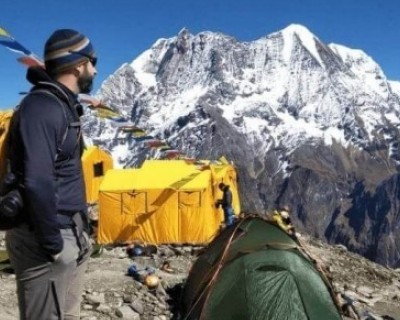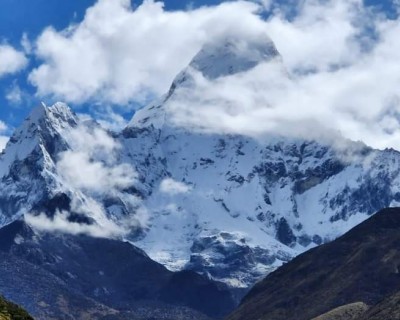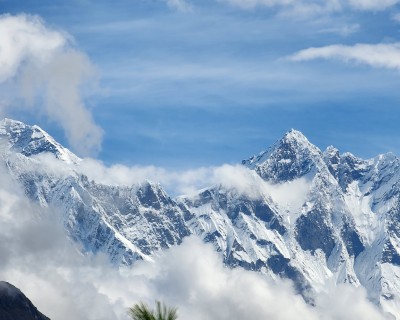Arrival in Nepal
The Annapurna Base Camp Trek is one of the most popular treks of Nepal. The trek takes you to the heart of the Annapurna Sanctuary at the Annapurna Base Camp. Situated at the foot of the world's 10th tallest mountains, the Annapurna Base Camp rests at an elevation of 4,130 meters above sea level. This trek is beautiful not only for its mountains but for the unparalleled natural and cultural beauty that can be found in this region.
The Trek Begins
Your journey begins at the City of Lakes, Pokhara. A mild trailer of the diverse landscape and culture from your stay at this lively city- which further ignites more thirst for the adventurer in you. Trekking begins from here as you head out to Tikhedhunga. Enroute, you witness gorgeous bamboo forests and gushing waterfalls. Your next destination is Ghorepani. You climb through steep stone steps, cross suspension bridges along with dense pasturelands until you finally reach Ghorepani. Ghorepani gives you spectacular panoramic views of snow-clad peaks in the horizon. Not far from Ghorepani is Poonhill, a famous vantage point known to provide the best views of the Annapurna massif. You head out for Poonhill early in the morning to witness a mesmerizing view of the sun rising over the mountains.
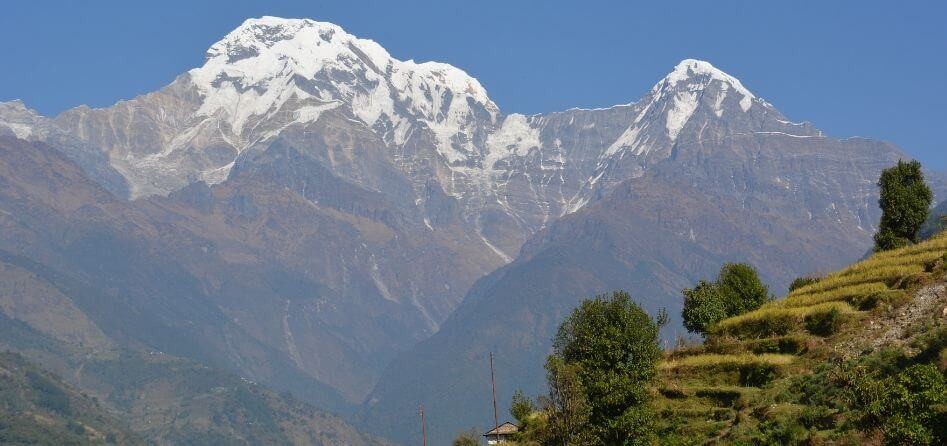
Journey to the Annapurna Base Camp
After a heart-warming session of mountain viewing, you resume your trek towards Tadapani. You continue your descend from Tadapani towards the Chhomrong village. Chhomrong lies amidst rhododendron and oak forests. Populated with Gurung people, this is an opportunity for you to immerse yourself in the cultural beauty of this community and get a deeper insight into their lifestyle. The next day, you leave for Journey to the Dovan. You make your way across the Chhomrong River and ascend towards Dovan through rocky tails covered with forests. On your way, you can enjoy the bio-diversity of the Annapurna Conservation Area. Further away from Dovan, your resume on your ascent towards Deurali. Finally, as you reach the Hinku ridge, you prepare for the big day tomorrow.
The Return Trip
You will now be heading towards the Annapurna Base Camp (4130m), making your way through the Machhapuchhre Base Camp (3700m). The Machhapuchhre Base Camp lies at a short distance from Deurali. From here, you see spectacular close up views of the Annapurna ranges and the Mt. Machhapuchhre (6997m). As you make way towards the Annapurna Base Camp, you see that the vegetation gets sparse as you ascend. When you finally reach the base camp, a surge of accomplishments goes through your body. The imperial elegance of the snow-clad peaks melts your heart and leaves you breathless. All your hard work and exhaustion from the trek is paid off by the mighty rewards you get from this moment.
Difficulty Level of Annapurna Base Camp Trek
It is a general assumption that trekking in the Himalayas is a challenging task. As such, trekking is an adventure sport that definitely exerts physical strain on an individual. Likewise, the Annapurna Base Camp Trek may seem difficult to most trekkers. But, in fact, it is not considered a difficult trek in comparison to other treks in the Annapurna region. A definite term for its difficulty level could be - ‘moderate’. The trek no-doubt requires at least some level of physical fitness as most of the journey is walking on trails that go up and down; but, it does not demand it at extremes. One could prepare themselves by exercising their cardiovascular abilities and flexibility to have an easier time during the trek. Nevertheless, anyone can enjoy this thrill-packed trip.
Here is a detail of the day to day events that takes place during the Annapurna Base Camp Trek.
Day 01 - Arrival in Kathmandu. Preparation for the trek.
Day 02 - Drive from Kathmandu to Pokhara - Approximately 200 kilometers (6-7 hours), altitude: 820 meters
Day 03 - Trek from Pokhara to Tikhedhunga - 9 km (4 hours), altitude: 1540 meters
Day 04 - Trek from Tikhedhunga to Ghorepani - 13 km (7 hours), altitude: 2880 meters
Day 05 - Early morning hike to Poonhill (3193m) followed by a trek to Tadapani - 9 km (7 hours), altitude: 2630 meters
Day 06 - Trek from Tadapani to Chhomrong village - 8.5 km (5 hours), altitude: 2170 meters
Day 07 - Trek from Chhomrong to Dovan - 9 km (5 Hours), altitude: 2600 meters
Day 08 - Trek from Dovan to Deurali - 7.8 km (4 Hours), altitude: 3230 meters
Day 09 -Trek from Deurali to Annapurna Base Camp via Machhapuchhre Base Camp (3700m) - 8 km (6 hours), altitude: 4130 meters
Day 10 - Return trek from Annapurna Base Camp to Bamboo - 18 km (7 hours), altitude: 2310 meters
Day 11 - Return trek from Bamboo to Jhinu Danda Hot Spring - 12 Km (6 hours), altitude: 1780 meters
Day 12 - Return from Jhinu Danda to Pokhara - 5 km (3 hours hike, 2 hours’ drive)
Day 13 - Return back from Pokhara to Kathmandu – (6-7 hours), altitude: 1300 meters
Day 14 - Departure from Kathmandu
Annapurna Base Camp Detail Itinerary
Day 01 - Arrival in Kathmandu. Preparation for the trek.
You arrive at the Tribhuvan International Airport situated in Kathmandu, the capital of Nepal. A company representative will receive you here and take you to your hotel. If you have time, you may explore the city for a while. Or, you can rest and prepare for your trek.
Day 02 - Drive from Kathmandu to Pokhara - Approximately 200 kilometers (6-7 hours), altitude: 820 meters
Today, your journey to the Annapurna Base Camp begins. You have two options to reach Pokhara; by a 6-hour drive or a 25-minute flight. Both these journeys offer dramatic landscapes and scenic views. The route is filled with lush green forests, farmlands, and gushing rivers beneath the winding highways.
Day 03 - Trek from Pokhara to Tikhedhunga - 9 km (4 hours), altitude: 1540 meters
After a joyful night at the lively city of Pokhara, you head out the next morning for Nayapul. Nayapul is situated approximately 42 kilometers away. You drive up to Nayapul via Lumle. From here, the trek begins as you head towards Tikhedhunga. Enroute, you pass through gorgeous bamboo forests, waterfalls, lush pastures, and the beautiful town of Birethanti. This will be your first altitude ascension as you gradually make your way upwards to Tikhedhunga. You will cover a total distance of 9 kilometers on foot, which requires about 4 hours to complete.
Day 04 - Trek from Tikhedhunga to Ghorepani - 13 km (7 hours), altitude: 2880 meters
Today, you will continue your way on the ascension towards Ghorepani. Ghorepani is situated at 2,880 meters; which makes it almost 1400 meters higher than Tikhedhunga. You also cross the 2,400-meter altitude mark on the trek which shows symptoms of altitude sickness; thus, you have to start being extra careful from here. A short distance from Tikhedhunga is the Magar village of Ulleri. After a climb over steep stone steps, you reach this village at an altitude of 1960 meters. Trekking through forests, streams, and pastures; you finally reach Ghorepani at 2,880 meters. The distance from Tikhedhunga to Ghorepani is approximately 13 kilometers and can be covered in almost 7 hours. The panoramic views of Annapurna, Tukuche, and Hiunchuli ranges are clearly visible from Ghorepani.
Day 05 - Early morning hike to Poonhill (3193m) followed by a trek to Tadapani - 9 km (7 hours), altitude: 2630 meters
For today's trek, you will wake up early in the morning to make it to Poonhill just in time for the sunrise view. Poonhillis situated at an altitude of 3,193 meters. The views, especially with the sun rising over the backs of the Annapurna and Dhaulagiri ranges are mesmerizingly beautiful. After a joyful session of mountain viewing, you make your way back down to Ghorepani and continue your trek towards Tadapani. It takes about 7 hours to complete the walk from Ghorepani to Poonhill and all the way to Tadapani.
Day 06 - Trek from Tadapani to Chhomrong village - 8.5 km (5 hours), altitude: 2170 meters
Again, today you make your way downwards to a lower altitude. Chhomrong lies approximately 8.5 kilometers away from Tadapani and it takes about 5 hours to reach there. Chhomrong is a village encircled by lush Rhododendron and oak forests where a majority of Gurung people live. Enroute, you also come across the gateway to the Annapurna Sanctuary. The Annapurna Sanctuary is decorated with rich flora and fauna. Keep your eyes open for you might see a number of unique species of animals and birds inside this region. As you reach Chhomrong, you meet the local people of this village and get to see their culture first hand. This is an opportunity for you to observe and learn about their culture that they have managed well to preserve.
Day 07 - Trek from Chhomrong to Dovan - 9 km (5 Hours), altitude: 2600 meters
From Chhomrong, you again start ascending. As you leave the village, you descend through stone steps till the Chhomrong River where you cross it through a suspension bridge. From here, you climb up a rocky trail through Sinuwa village. From here, you make your way through trails leading up and down until you reach Dovan.
Day 08 - Trek from Dovan to Deurali - 7.8 km (4 Hours), altitude: 3200 meters
Today you trek for a comparatively short distance. Deurali is almost 8 kilometers from Dovan and is situated at 3,200 meters of elevation. The trail is filled with bamboo forests and blooming Rhododendron trees. You make your way towards the Hinku ridge and finally ascend its peak to reach Deurali. The Modi River will keep you company all the way to Deurali.
Day 09 -Trek from Deurali to Annapurna Base Camp via Machhapuchhre Base Camp - 8 km (6 hours), altitude: 4130 meters
Finally, today is the day you reach your ultimate destination; the Annapurna Base Camp. The morning begins with a gentle climb through the train that descends steeply over the mountainside. After a short trek, you reach the Machhapuchhre Base Camp. You can enjoy a gorgeous view of the Hiunchuli (6441m), Annapurna South (7219m), Annapurna I (8091m), Annapurna III (7555m), and the neighboring peaks from here. Forth, you make your way through the sparse vegetation and almost after 2 hours you reach the Annapurna Base Camp. This is the highest point of your trek at 4,130 meters. From the lap of this marvelous mountain, you witness the sun rising over the vertical south face of Annapurna that towers above you. It truly is a blissful experience to stand on the foot of the world’s 10th tallest mountain.
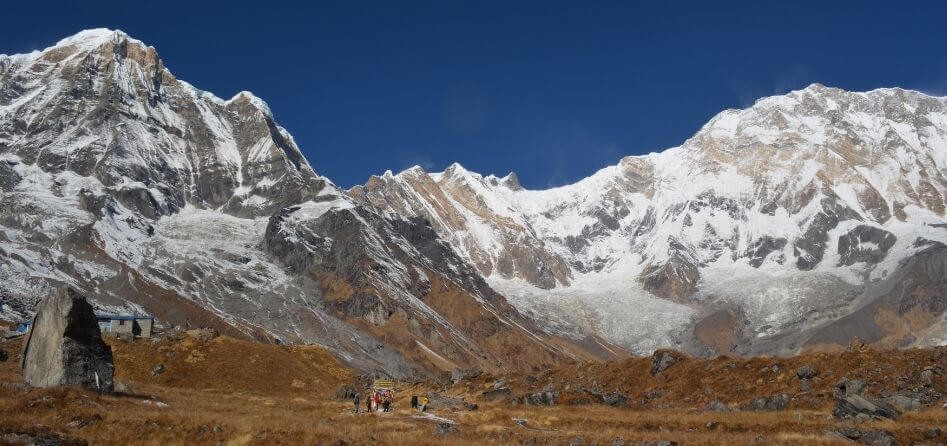
Day 10 - Return trek from Annapurna Base Camp to Bamboo - 18 km (7 hours), altitude: 1700 meters
Today, you make your way through the same trail to Modi Khola at Bamboo. You make a descent to about 1700 meters at Bamboo. The distance between these two destinations about 18 kilometers and is the longest trek on the whole trip. There are plenty of lodges to choose from in this place.
Day 11 - Return trek from Bamboo to Jhinu Danda Hot Spring - 12 Km (6 hours), altitude: 1780 meters
Your day starts as you head towards Chhomrong. Enroute, you pass through a sheep farm in Kuldighar. The trail is encompassed by lush green forests and colorful Rhododendron trees. As you reach Chhomrong, the trail turns steep downwards towards Jhinu. In about 6 hours, you complete the 12 kilometers distance and reach Jhinu Danda. Here you get to take a rejuvenating bath at the natural hot springs. Relish the relaxing waters and the surrounding views at Jhinu Danda.
Day 12 - Return from Jhinu Danda to Pokhara - 5 km (3 hours hike, 2 hours’ drive)
From Jhinu Dada, you follow the Modi River as you walk beside it until Siwai. Siwai is about 4.4 kilometers from Jhinu Danda and can be covered in about 3 hours. As you reach Siwai, a vehicle will take you back to Pokhara. Once at Pokhara, you can choose to explore the attractions in the Pokhara Valley.
Day 13 - Return back from Pokhara to Kathmandu
Today, you hop on your car or take a flight back to Kathmandu. Take in the beautiful scenery of the diverse landscapes one more time. After you arrive in Kathmandu, you may spend the day at your hotel relaxing or explore the city. You can also shop for souvenirs and gifts as you near your vacation in Nepal.
Day 14 - Departure from Kathmandu
Finally, your stay in Nepal comes to an end. Hopeful, your journey goes higher than your expectation and you take home pleasant memories of it. As you depart, fill your heart with the final glimpse of the Nepali terrain as you fly above and beyond.
Annapurna Base Camp Altitude
The Annapurna Base Camp Trek definitely is a high altitude trek; considering it is to be done in the Himalayan region of Nepal. But in comparison to its next big alternate choice the Everest Base Camp trek, the Annapurna Base Camp Trek goes a little lower in altitude. The Annapurna Base Camp is located at an elevation of 4,130 meters above sea level. This is also the highest point of the trek. The major aspect that makes this trek the adventure that it is, is the High Altitude. Your journey begins from Pokhara, the lively city besides the lake which is situated at an altitude of 820 meters above sea level. The mountains dominate the skyline afar and you realize how close you have come already to the great Himalayas. You proceed on your journey through the various stops on your way towards the Annapurna Base Camp. From Pokhara, your first destination is Tikhedhunga at 1,495 meters. Onwards, you go through Ghorepani (2.880 meters), Poonhill (3,193 meters), Tadapani (2,630 meters), Chhomrong (2,170 meters), Dovan(2,600 meters), Deurali(3,200 meters), Machhapuchhre Base Camp(3,700 meters), and finally Annapurna Base Camp at 4,130 meters.
Annapurna Base Camp Altitude Chart
Located in the Himalayan region, the Annapurna Base Camp Trek is done in this region where the altitude stretches from 3,000 meters and above. Even though most of the trip is below 3,000 meters; the trip is still considered as a high altitude trip and you must take every precaution to be safe during travel. During this trip, you will be spontaneously going up and down in altitude. A brie chart displaying the various altitude changes is given below:
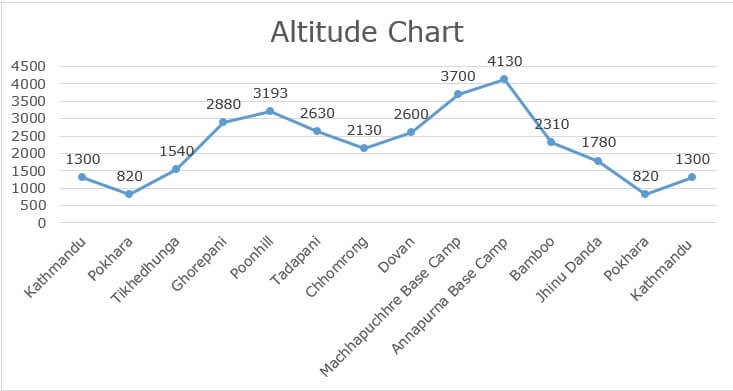
Best Season to do the Annapurna Base Camp Trek
Nepal experiences 4 different seasons: spring, summer/monsoon, autumn, and winter. The best seasons to do the Annapurna Base Camp Trek are autumn and spring. Here is what each season serves its travelers with:
Spring (March, April, and May)
The spring season is the next best option after autumn. Spring brings a colorful atmosphere into the Annapurna region. As the snow from the winter melts, the weather is pleasant and the trails are dry. There is little to no chances of rainfall thus, the views are clear as well. However, the upper regions above are still very cold during spring. The average temperature is around 10 degrees in the lower regions with colder nights. However, regions above 4,000 meters are extremely cold.
Summer/Monsoon (June, July, and August)
The summer season isn't quite the best time to be traveling in the Annapurna region. It is very hot during this season and there are frequent downpours. Due to rain, the trails become wet and slippery and the views are blurred with the cloud. This also brings in risks of avalanches and mudslides. Rainfall and bad weather can interrupt your trek and delay your trek completion time.
Autumn (September, October, and November)
The autumn season is the best time to go for the Annapurna Base Camp Trek. During this time, the trails will be bustling with trekkers from all over the world. As the rain settles and the weather clears, there is no other time better than this to go for a trek. The average temperature during the day time is around 15 degree Celsius with 7 degree Celsius during night time. The region above 4,000 meters experiences temperature drops below 0 degree Celsius. However, autumn guarantees the best view of the Himalayas so, it is the ideal season to undertake the Annapurna Base Camp Trek.
Winter (December, January, February, and March)
Both the lower and upper region during this time of the year is very cold. The weather with the temperature makes trekking very difficult. The lower regions have temperatures hanging around 5-10 degree Celsius during the day and below zero during the night. Altitudes above 4,000 meters have on an average around 3 degree Celsius even during the day. Trekking will be extremely difficult during this season and some places are even closed due to the weather conditions. Trekkers opting for winter are up for extreme difficulties; thus, if you are choosing the winter season- be aware of the region beforehand!
Altitude Sickness
The idea of trekking to the foot of the world’s 10th tallest mountain surely does not sound easy. The major factor to make a rise in the difficulty level is the altitude. The Annapurna Base Camp Trek is a high altitude trek that takes you to the Himalayan region. Traveling at high altitudes brings about several risks; one of the most deadly risks is altitude sickness. The risk of falling victim to altitude sickness starts at around 2,400 meters above sea level. Due to its deadly nature, it has no cure. Thus, one must know about this matter beforehand and take precautions to prevent it- or know what to do when they are affected.
Causes of Altitude Sickness
At high altitudes, the atmosphere has thinner air resulting in low amounts of oxygen. When a body is unable to adapt to the changing levels of oxygen s/he suffers from various symptoms. Not being able to acclimatize is the major cause of getting altitude sickness. The body is not able to acclimatize for various reasons. The second cause is when a person ascends altitudes at a faster pace than she can adapt to it. When you head out from Chhomrong, you cross the 2,400 marks and thus get vulnerable to altitude sickness. From here onwards the maximum altitude you will reach is 4,230 meters at the Annapurna Base Camp. During the course of the trek, you will be shifting in altitudes around 500 to 600 meters per day. Thus, it is crucial for you to be careful regarding altitude sickness on the Annapurna Base Camp Trek.
Symptoms of Altitude Sickness
The most common symptoms of altitude sickness are headache, nausea, vomiting, and lightheadedness. These symptoms usually start showing around 12 to 24 hours of altitude ascension and can vary according to the person and the level of altitude. If proper acclimatization is done, these symptoms can lessen within a day or two. Additional symptoms include cough and gray, pale, or bluish skin tone.
Precautions and Remedies of Altitude Sickness
As there is no cure for altitude sickness, there are few things you can do to prevent it or get in the safe zone. The best things to do when a person is affected is to take them down to lower altitudes immediately. Better than this is to act to prevent altitude sickness. To prevent getting sick, there are a few measures you can take. Firstly, regulating a proper pace and pattern helps your body adapt to the atmospheric pressure. This also lessens the pressure you exert on your body. Most people overestimate abilities or try to complete the trek faster. But if you take it slow and let your body acclimatize to the atmosphere - this reduces the chances of getting sick. It is also vital to stay hydrated throughout the trip. The recommended amount of water to drink per day is 5 liters. Another helpful tip is to sleep at lower elevations. During your trip, you will be covering 500 - 600 meters of altitude per day. It helps if you only change your sleep elevation no more than 300 to 500 meters. In cases of emergencies, medications such as Diamox can help you speed up the process of acclimatization. But these medications are only to be taken with the doctor’s permission.
5 Related Treks in the Annapurna Region
Annapurna Circuit Trek
The Annapurna Circuit Trek is one of the best ways to explore the amazing beauty Nepal has to offer. Constituting of natural as well as cultural beauty, the Annapurna Circuit Trek is a perfect blend of numerous factors that represent the Annapurna region. The Annapurna Circuit Trek takes you through lush subtropical vegetation to the desert like alpine lands. Beginning from Besisahar, the trek heads north towards Jagat. Heading further ahead, the trek continues along the Marsayangdi River through Rhododendron forests. Reaching Chame, the trek reaches Pisang and heads to Manang. Continuing to the altitude of 5,416 meters at the peak of Thorung La Pass, it is the highest point of the trek. From the top of the pass, you witness a mesmerizing panoramic view of the Annapurna ranges along with the Dhaulagiri massifs. The Annapurna Circuit Trek Distance is 211 kilometers and requires 14 days to complete. Due to the rough trails and long distance, this trek is quite difficult and requires good endurance.
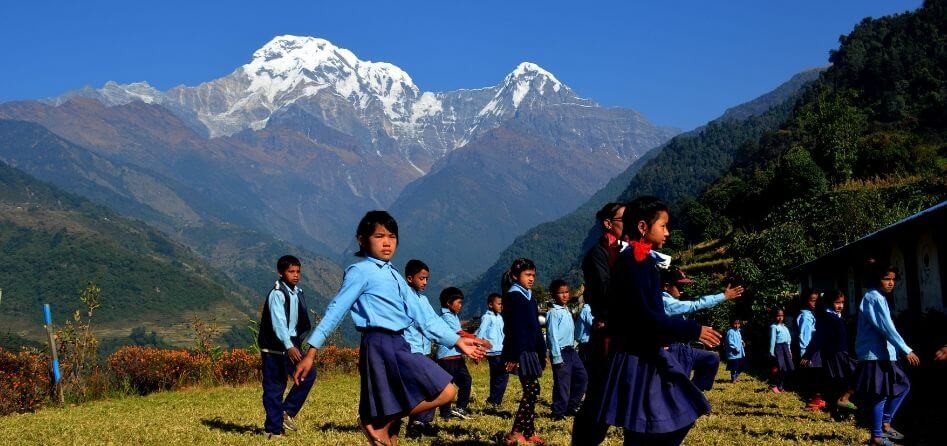
Ghorepani Poonhill Trek is probably one of the best short treks that show you the beauty Nepal holds. There is not an easier and better way to witness the Annapurna region than the Ghorepani Poonhill Trek. The Ghorepani Poonhill Trek takes you through the lush green forest, ethnic villages and up to the vantage point of Poonhill which is located at 3,193 meters above sea level; also the highest point of the trek. Here you get remarkable views of the Annapurna ranges along with Mt. Machhapuchhre (6997m), Lamjung Himal (6983m), and Hiunchuli (6441m). Especially, if you make it in time for sunrise, the view of the sun shining over the snow-clad peaks are priceless! The Ghorepani Poonhill Trek is a 10-day journey where you cover a distance of 51 kilometers. Explore the natural beauty as well as get a chance to meet the ethnic people of the local communities on the Ghorepani Poonhill Trek. This trek is perfect for those who are limited by time but want to enjoy the Himalayas.
With the immense beauty of the Annapurna Circuit Trek, you get to enhance your journey by adding on the option to visit the Tilicho Lake Trek. Tilicho Lake is the highest located lake on earth, making it one of the most adventurous journeys one could possibly go on. It is situated at an elevation of 4,920 meters above sea level. Its distinct emerald glow and the thrill it provides is the major highlight of this trip. Though the Tilicho is at such a height, it is not the highest point in this trek. The highest point of this trek is the Thorung La pass at 5,416 meters; from where you witness the glorious Annapurna and Dhaulagiri massifs. The Annapurna Circuit with Tilicho Lake Trek extends the trip to 17 days making it more strenuous than the basic version. You cover about 230 kilometers during this trek which makes it a difficult journey for beginner trekkers.
The Annapurna region consists of endless beauties and the Jomsom Muktinath Trek is one that unfolds this beauty to you. This trek is a perfect blend of nature with culture. Through the course of this trek, you witness lush green vegetation, rugged trails, dry desert-like lands, and phenomenal mountain views. As you reach the Muktinath Temple, you submerge yourself spiritually to the surrounding. Cleanse yourself and get purified by taking a bath under the 108 spouts of the Muktinath Temple. The Jomsom Muktinath Trek is for those who wish to experience high altitude traveling and enjoy the company of rough and dry terrain. The trek is considered as a high altitude trip and the maximum altitude you will reach is 3,760 meters at Muktinath. It is suitable for all types of trekkers and is a wonderful way to explore the Annapurna region.
The remote areas of Annapurna region call for exploration and Mardi Himal Trek are the perfect way to experience it. The Mardi Himal Trek takes you to the remote settlements of the Annapurna region where there is seldom any traffic. With the Mardi Himal (5553m) in the backdrop, the rugged trails run beside the rivers. The trails are decorated with lush green forests of Oak, Pine, Juniper, and Rhododendron trees. Upon reaching the Upper Viewpoint from Mardi which is located at an elevation of 4,200 meters and is also the highest point of this trek, you witness views of mountains such as Mardi Himal (5553m), Annapurna ranges, and Machhapuchhre (6997m) along with Dhaulagiri Massifs and many smaller peaks. During the course of the trek, you also visit the local settlements where you meet the ethnic people of the Gurung tribe. This gives you the opportunity to observe and learn about their unique culture and lifestyle. The Mardi Himal Trek is a 10-day journey which covers a total distance of 64 kilometers during the trek. This trek is moderately easy and is suitable for all types of trekkers.
Packaging list while doing the Annapurna Base Camp Trek
Like any other trek, your experience relies heavily on the preparation you have for the journey. Likewise, packing your bags with the correct items is one of the most important parts of preparation. One major advantage this serves is, you have all the essentials you need for your trek which helps you overcome any obstacles you may face on your way. Having the right clothing and gear also helps you to stay comfortable and ready for any physical activity. Packing the necessities also means having a proper load for your trek which results in lighter backpacks. The basic packing list consists of clothing(depending on the season of travel), trekking equipment/gears, personal supplies, general, and necessary medications, first aid kit, and a few personal items. Here is a more detailed list of what you should carry for the Annapurna Base Camp Trek.
Clothing
- Light thermal inner wears
- Fleece jacket or pullover
- Wind stopper jacket
- from the cold winds
- Waterproof jackets and trousers
- Lightweight thermal gloves
- Set of Undergarments
- Trekking Shorts
- Lightweight long trousers/pants
- Sun hat or scarf
- Warm fleece hat or light balaclava
- T-shirts(preferably sweat soaking)
- Thin, lightweight (inner socks)
- Thick warm wool hiking socks
- Waterproof shell mittens/gloves(insulated liners recommended)
- Insulated jacket with attached hood
- Heavyweight pants (for high elevations)
- Heavy down jacket
- Winter hat
Your clothing heavily depends on the season of your travel. For winters you may need more warm clothes whereas for summer you may need cooler clothes.
Equipment/Gears
- Trekking boots
- Camp sandals
- Sunglasses with UV protection
- Water bottles
- Trekking Poles
- Headlamp
- Sleeping bag (rated to 0 degrees recommended)
- Tent
- Sleeping pad/mat
- Silk Liner
Personal Supplies
- Medium sized towel
- Toothbrush/toothpaste
- Multipurpose soap
- Face and body moisturizer
- Nail clippers
- Sunscreen
- Hand sanitizer
- Face/body wipes
- Throat lozenges
- Lip balm
General Medication
- Plasters/Band-Aids
- Bandage for sprains
- Iodine or water filter
- General painkiller
- Antiseptic cream for cuts
- Blister medication
- Antibacterial throat lozenges
- Antibiotic tablets
- Oral rehydration salts
- Diarrhea medication
- Diamox (for altitude sickness)
This is a basic packing list for the trek- consisting of the essential items. In addition to this list, you can also carry some personal belongings such as cameras, books, cards or anything else that you may need during your trip.
Tips for including appropriate equipment
When you buy your equipment and gears, always keep a mind to invest properly on quality products. These equipment and gears are what will help you through your journey. For any of the items above, if you do not already own it or have left to purchase; you need not worry about it. There are plenty of stores in Nepal that have made these items available for purchase and rent. The best part of it is, you can get quality products for cheap prices. Stores are generally located in major cities.
Conclusion
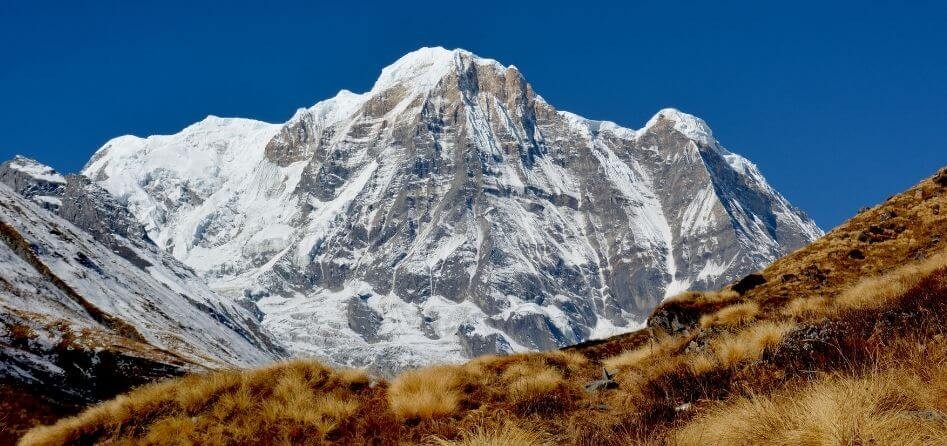
The Annapurna Base Camp Trek is one of the most sought-out treks in Nepal. Annapurna, the crown jewel of Nepal is decorated with immense natural and cultural beauty. As rewarding as it is, the Annapurna Base Camp Trek is moderately easy and suitable for all types of trekkers. There are several different routes to go about this trek. In conclusion, the Annapurna Base Camp Trek is definitely worth your time, resource, and effort.








